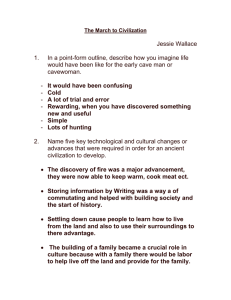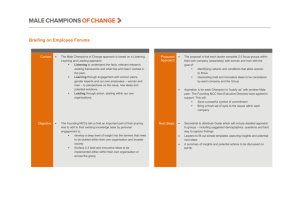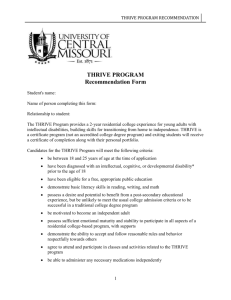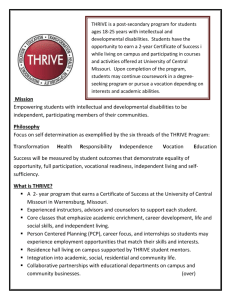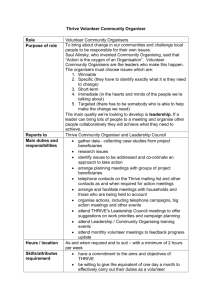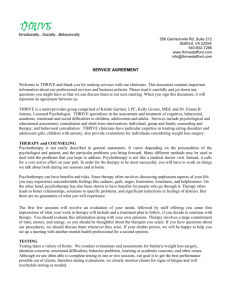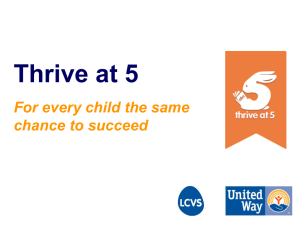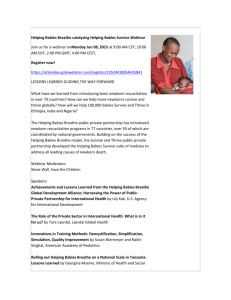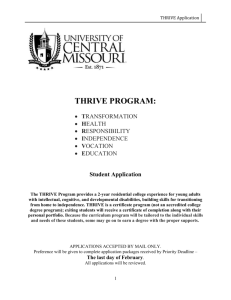THRIVE Policy - Rainbow Nursery Totnes
advertisement
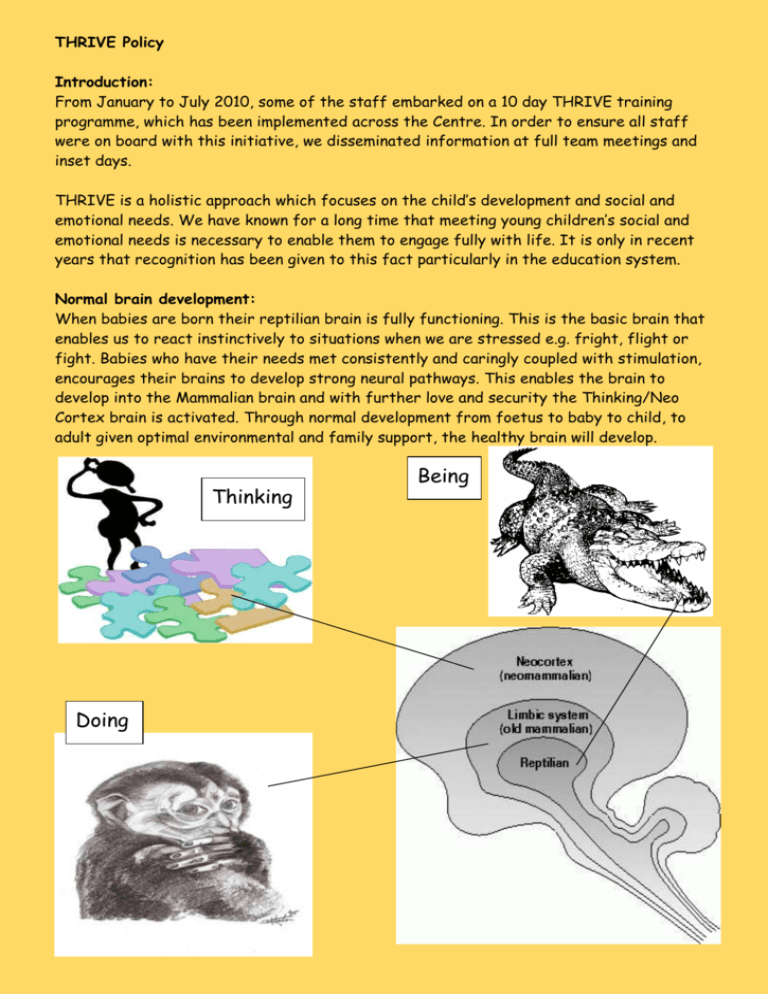
THRIVE Policy Introduction: From January to July 2010, some of the staff embarked on a 10 day THRIVE training programme, which has been implemented across the Centre. In order to ensure all staff were on board with this initiative, we disseminated information at full team meetings and inset days. THRIVE is a holistic approach which focuses on the child’s development and social and emotional needs. We have known for a long time that meeting young children’s social and emotional needs is necessary to enable them to engage fully with life. It is only in recent years that recognition has been given to this fact particularly in the education system. Normal brain development: When babies are born their reptilian brain is fully functioning. This is the basic brain that enables us to react instinctively to situations when we are stressed e.g. fright, flight or fight. Babies who have their needs met consistently and caringly coupled with stimulation, encourages their brains to develop strong neural pathways. This enables the brain to develop into the Mammalian brain and with further love and security the Thinking/Neo Cortex brain is activated. Through normal development from foetus to baby to child, to adult given optimal environmental and family support, the healthy brain will develop. Thinking Doing Being This diagram shows the three interlocking levels within the brain: The Reptilian brain – the most primitive inner core of our brain which houses our instinctive and primal reactions e.g. fear, rage, separation (BEING) The Mammalian brain (or limbic system) which enables us to respond like a Mammal e.g. love, nurture, protect, socialise, explore and have fun. (DOING) The Thinking brain (or Neo Cortex) – the most advanced brain which helps us to make measured choices about our actions (THINKING) Often children who are experiencing heightened emotional states at home or through being at nursery are functioning in a ‘Reptilian’ state of high anxiety and therefore unable to engage their thinking brains. Attachment: Apart from brain functioning, another one of the principles of THRIVE is the Attachment Theory which was developed by Bowlby (1969). Bowlby recognised that babies have an innate built-in system, which focuses on their relationship with the care-giving adult as a survival mechanism. Gradually, as the adult repeatedly provides emotional interactions, these positive experiences become an expectation in their memory and gives the child a ‘secure base’ in the world (Bowlby 1988). Parents bond with their babies in various ways. This can be influenced by historical or cultural factors; friends or family; economic or social and sometimes by educational factors. The primary Care Giver has a key role to play in supporting the child’s normal development through providing loving and attentive relationships. How our emotional state affects our brain’s ability to function: We are now beginning to understand the effect emotional upsets have on our brain’s function and how this impacts on our ability to cope. When we are in a state of high anxiety, frustration or anger our brain dysregulates and it is flooded with Cortisol. When we dysregulate our ability to cope is greatly reduced as the Cortisol puts us into a Reptilian state (like a crocodile), where only our basic survival instincts are a priority e.g. flight, fright or fight. This may be seen as screaming, shouting, crying, kicking, throwing, running, resisting, tantrums or possible totally withdrawing. When the Reptilian brain is activated we are unable to manage strong feelings and much more likely to over-react to negative situations. When in this state, with high levels of Cortisol, we are unable to calm and utilise the thinking part of our brain and thinking skills. We may need someone else to help us. Interruptions: Young children’s social and emotional needs can be affected by many events, depending on their sensitivity. For some children, who are highly sensitive, separating from their carer to attend childcare can be very distressing. For other children, they may experience major disruptions in their young lives, which impacts on their ability to cope with everyday life. Young children can have a variety of experiences and depending on the severity of the experience, coupled with their own resilience or sensitivity, their reaction will vary. The depth of a child’s secure attachment to their care-giving adult will influence how the child may cope with changes or happenings. The THRIVE approach refers to interruptions where the child, for whatever reason, experienced a separation from their care-giving adult i.e. through illness of child or parent, post natal depression, separation. THRIVE list these interruptions (Building Blocks) depending on the age of the child when the interruption occurred: A BEING interruption between 0-6 months A DOING interruption between 6-18 months A THINKING interruption between 18months and 3 years A child who has experienced a BEING interruption will need support to Have their needs met Stay safe Feel special A child with a BEING interruption may present as Wanting to control situations. When the child feels they are not in control, they may become angry or aggressive or have a tantrum This stems from the child feeling they need to be in control. Children behave as though they are the adult and need to make the decisions. They find it very hard to accept when an adult does this instead. Children, who fit this description, can be referred to as omnipotent. Withdrawn – low expectation of adult support A child who has a DOING interruption will need support to explore with safe boundaries make choices A child with a DOING interruption may present as Feeling helpless and insecure and struggles to make sense of the world around them Timid, lacking in curiosity and confidence. Fearful of exploring, experimenting, trying new things, getting messy / dirty Wanting to join in yet fear they will get things wrong, make mistakes and/or be ridiculed Believing that they can do everything “superhuman” or they can do nothing. Without experience of practice and rehearsal – they may believe they “Should” be able to do new things without understanding that everyone has to “learn” first to be able to master things. Expressing frustration or anger at self or others. This can be caused by a child being flooded with intense feelings that can cause a Flight, Fight or Freeze response. Not expecting an adult to be “alongside” them exploring OR unable to do anything on their own and expect an adult to be constantly present Shy or surprised when their new skills are recognised or celebrated by an attentive adult Finding it difficult to settle to tasks – may distract for fear that their lack of skills will be exposed Masking their need for help Observers rather than participants Often agitated and fidgety Poor body awareness in relation to environment – may bump into or fall over things Moves around with little connection to others as though they have ‘ants in their pants’ Children will flit from one activity to another, finding it very hard to get engaged in an activity so may need adult’s support to be shown how to play with or use a resource. Also they may feel baffled by the choice of activities so may need adult guidance to choose. A child with a THINKING interruption will need Support to engage their thinking brain To stop and think Support to develop thinking language This is a normal stage of development for children in the 3 and 4 year olds age range. A child may have an interruption at the next level of POWER and IDENTITY. How we can help: THRIVE provides a range of reparative processes which can help children. What can help? How do we do this: General: Using the 4 Vital Adult Child Regulating Functions Attuning – emotional and actual connection. We can show the child we understand their depth of anger or sorrow by matching their intensity of pitch and letting them know we can take those feelings from them and help them manage them. Containment – security and safely. Take the child in your arms and hold them (which provides physical and emotional support) reassuring them that you are the adult and you can help with their anger/fear/upset Soothing and calming – holding physical and emotional. ‘Ah, there, there’ and physically calming the child. We can attune by mirroring the child’s facial expressions, body language, gestures, noises. Use a voice which reflects the child’s tone of voice. We can contain by cuddling the child – holding them very close and letting them feel very safe. This can be good with children when they have done something negative, like hurting somebody, as they are unhappy inside. If you can’t sit them on your lap, rub their back and reassure them that ‘I am the adult, I can keep you safe’. Containment can also be used if the child is having a ‘meltdown’. The adult sits on the floor and holds the child between their legs – holding their arms across their tummy (NOT chest). The adult needs to remain very calm, reassure the child and wait until the child calms. We can sooth by mimicking those words and actions used with babies – slowly rocking, speaking in a soft calm voice, gently rubbing the child’s back and arms – if they like being touched. Validating – reflects, mirrors, absorbs, understands e.g. saying to the child ‘I can see you are really angry, am I right?’ ‘I am the adult, I can keep you safe’. Being We need to remain calm and in control of our own emotions particularly when the child is dysregulating. This will help the child considerably. Making the child feel special through giving them lots of eye contact, going down to their level to talk to them, listening attentively to their chatter and responding enthusiastically. Every member of the team greets the individual child and adds a positive comment about their appearance. This needs to be done over 500 times to start reassuring the child’s Reptilian brain. Continuity Doing Providing ‘therapeutic play’ situations which give the child an opportunity to express how they may be feeling emotionally. This may help, as the child may find it difficult to talk about their emotions because of their age. It may be that you use this approach after the child has had a ‘meltdown’ to understand the triggers. Exploring alongside the adult We can validate, when a child is having a ‘meltdown’, by saying ‘I can see you are feeling very very angry, am I right?’ Using a calm voice to reinforce our message Breathing – keeping a loud, calm and deep rhythm of breathing so the child can hear you breathing in and out and that you are regulated Playing games which enhance the 1:1 relationship between child and adult e.g. face feather tickling (get the child to close their eyes and run a feather lightly over their face) feather ‘keepy uppy’ (stand up facing each other and throw a feather in the air, and blow it using straws to keep it in the air) massaging baby lotion into each other’s hands and face paying them lots of compliments with genuine interest Everybody doing the same thing at home and at the setting Give the child some drawing materials and ask them to draw how they feel inside Offer the child a sand tray and figures to portray how they are feeling Clay can be useful either to make figures to represent their feelings or just use the clay for some controlled throwing e.g. put some plastic on the floor and let the child throw the clay as hard as they like Small world play Puppets/dolls/soft toys music The adult supporting the child by modelling play, exploration and joy of discovery to help the child discover the pleasure of play. Treasure Play and other open ended materials/environments can support this. What we have in place: We have revised our Individual Education Plan into a THRIVE plan which we will use to inform the DAF 2a as appropaite. The THRIVE plan contains all the universal provision within our setting that can support all children’s needs. There are also boxes to outline specific targets individually and during small or whole group sessions. The THRIVE plan is looked at with parents and strategies selected which can support the child. These are highlighted by SENCO and then signed by the parent and used by the Pre-School teams. A THRIVE assessment with the child’s parents - the child’s key person is able to look at the THRIVE programme to pull out some specific strategies to support the child Our golden rules including ‘Stay Safe’ - these can be useful at home as well as PreSchool Please refer to our Behaviour Policy Completing a THRIVE assessment If you decide to complete a THRIVE assessment with an early years child – explain to the parents that we are trying to meet their child’s needs and the programme can help us to do that. Seek parental signature on the consent form Parents to complete observed behaviours form Keyperson to complete the observed behaviours form THRIVE practitioner and the keyperson / SENCO to work through the computer programme Outcomes to be shared with the parents and the wider team to support key strategies. Policy formulated on: May 2010 Policy last reviewed on: May 2014 Signed:
